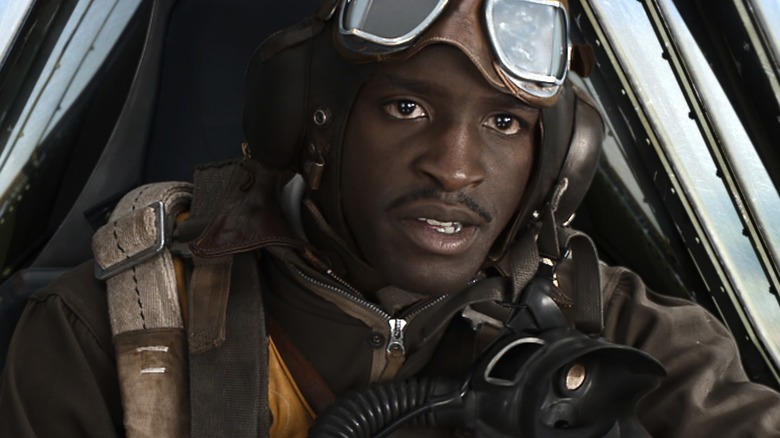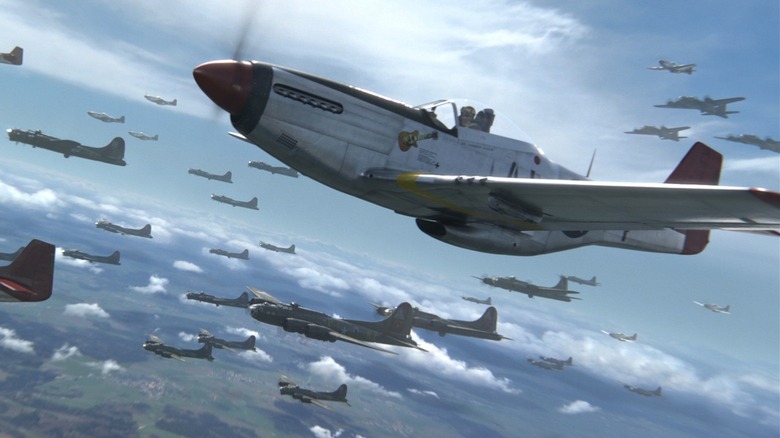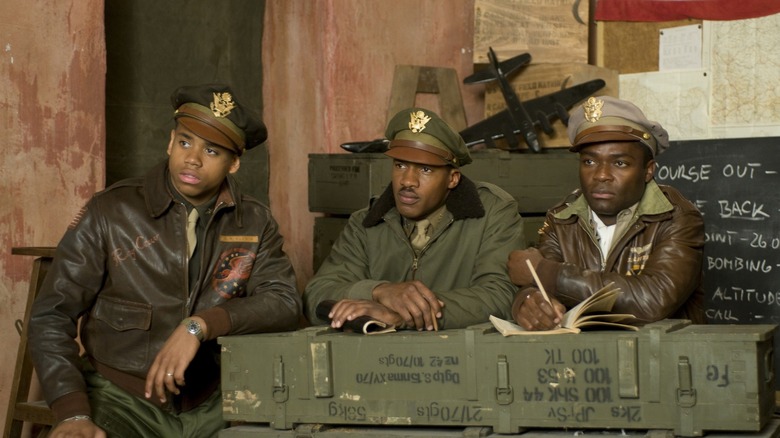Tales From The Box Office: How Red Tails Ended Lucasfilm's Pre-Disney Era With A Whimper
(Welcome to Tales from the Box Office, our column that examines box office miracles, disasters, and everything in between, as well as what we can learn from them.)
Lucasfilm will always be tied directly and most closely to "Star Wars," one of the biggest, most beloved, and influential franchises in cinematic history. But let us not forget that the studio had other movies under its belt, including the "Indiana Jones" movies and "Willow." As most of you reading this likely know, Lucasfilm was eventually purchased by Disney in 2012 in one of the biggest, game-changing deals of the modern era.
But before George Lucas sold the company that he built from the ground up with his space movie that nobody believed in, he had one film left in him, and it was a passion project that had been many, many years in the making. That movie was the World War II flick "Red Tails," which ultimately failed to make much of a splash and concluded Lucasfilm's pre-Disney era on a pretty uninspired note. Today, we're going to look back at the movie's long road to theaters, what happened when it finally did hit theaters, and what went wrong.
The Movie: Red Tails
The tale of "Red Trails" truly goes back to the '40s, as it was inspired by the famed Tuskegee Airmen — though it's a largely fictionalized account of real events. Here's the official synopsis:
Subjected to intense racism at home, the African-American pilots known as the Tuskegee Airmen are given a rare opportunity to prove their bravery in the fight over Europe. Flying the latest aircraft with distinctive tails painted red, the fighter squadron must overcome adversity in its many forms.
As the story goes, George Lucas began developing "Red Tails" way back in 1988 and, at one point, it was eyed for release in 1992. Only missed that target by 20 years, no big deal. What may not come as a surprise to those familiar with Lucas' work is that he originally envisioned this as a pretty epic tale, with references made to "Laurence of Arabia" at times. Several different filmmakers were considered during its various stages of development. Famed producer Rick McCallum, who worked with Lucas on the "Star Wars" films, was alongside his friend and collaborator for the adventure.
Lucas got distracted with project after project, with "Young Indiana Jones" getting in the way, then the 1997 "Star Wars" re-releases (dubbed the "Special Editions"), which then led right into the prequel trilogy. But once "Revenge of the Sith" was released in 2006, the runway was finally clear to make "Red Tails" a top priority. Ironically enough, McCallum, speaking to Den of Geek in 2012, revealed that they decided not to go with the bigger version of the movie as "every epic film had been a financial disaster, and we felt there just wasn't an audience we could get the film out to." Not to spoil anything but it turns out that there wasn't really an audience for the two-hour version of it either.
After much development, Anthony Hemingway, primarily known for his work in the TV space, was selected to direct "Red Tails." An up-and-coming writer by the name of John Ridley (who would go on to win an Oscar for his work on "12 Years a Slave") penned the draft of the screenplay that ended up getting made. The stage was mostly set.
One thing that made this movie unique, especially at the time, is that it featured a primarily Black cast. While Hollywood's thinking indicated that might limit its audience, the cast was filled out with talent. Cuba Gooding Jr. led the way and it marked his first major role in a studio film since "Daddy Day Camp" and "American Gangster" arrived in 2007. Terrence Howard, who was not busy with "Iron Man 2," also boarded the project. But some of the biggest names, in hindsight, were Michael B. Jordan, David Oyelowo, and Leslie Odom Jr., who have since become some of the biggest, most in-demand stars in the business.
The production of "Red Tails" was long and messy, kicking off in January 2009 with massive reshoots eventually taking place in March of 2010. Lucas took over directing duties for the extensive additional photography, as Hemingway was busy with his series "Treme." Eventually things got squared away and 20th Century Fox (another studio destined to eventually be bought by Disney) opted for a January 2012 release. Given that, especially at that time, the month was largely viewed as a dumping ground, the writing was pretty much on the wall.
The Financial Journey
"Red Tails" hit theaters on January 20, 2012. Unfortunately it faced stiff competition as "Underworld: Awakening" was also debuting, as was the action flick "Haywire." Not to mention the expansion of the Oscar-nominated "Extremely Loud & Incredibly Close." To make matters worse, Lucas' passion project was not met with a warm welcome from critics at the time. "Red Tails" currently holds a 40% approval rating on Rotten Tomatoes. With plenty for moviegoers to choose from and a lack of must-see buzz, a recipe for disaster was written.
The movie debuted to $18.7 million in its opening weekend, which wasn't outright disastrous given its reported $58 million budget. The problem was, it ran out of juice pretty quickly, taking in $10.3 million in its second frame, and a rough $4.7 million in weekend three. In total, "Red Tails" grossed $49.8 million at the domestic box office for its entire run. Again, by modern standards, there might be reason to think that hope was on the horizon with robust international markets eager for Hollywood films. Unfortunately, this movie had virtually no international rollout as, at the time, there was very little overseas appetite for a WWII movie with an America-centric story.
With that in mind, "Red Tails" made just $489 thousand overseas in total, barely making a dent in what was needed to recoup the movie's budget. Keeping in mind that only about half of ticket sales get back to the studio, this one finished in the red in a big, bad way. Yes, the home video market was a little more robust a decade ago, but not enough to save this from being a flameout. Especially when considering that one of the most influential filmmakers in history had been working on this for well over 20 years.
The Lessons Contained Within
Truth be told, this one is tough to look at from a pragmatic-minded, good business sense standpoint. It's hard to extract any big lessons that studios, from my point of view, should avoid in the modern era. On paper, "Red Tails" had everything going for it: Lucas doing something big after wrapping up his work in the "Star Wars" universe; a promising up-and-coming director; a future Oscar-winning screenwriter; a unique story; and one heck of a cast. It's just a shame all of those pieces didn't ultimately make for a better movie in the end. It's tough to blame Fox for dumping it in January given that it ended up being a film that critics and audiences roundly rejected.
Sadly, this was the last entry in Lucasfilm's pre-Disney filmography as Lucas himself decided it was time to cash out and call it a day. We know that Lucas had plans for another "Star Wars" trilogy around this time but then, because he was valuing his time in his older age more and more, he decided to hell with it. Cash a big $4 billion check and let Disney do what they want with the worlds he spent his life building. Lucas ended up being pretty unhappy with the direction the sequel trilogy went in, completely abandoning his planned Episode VII story in favor of what became "Star Wars: The Force Awakens."
It's not hard to see how "Red Tails" might, in some way, have also informed Lucas' decision to sell. The man had made all of the money that one could want and adding more money to the pile like Scrooge McDuck wasn't going to fill any hole he had inside of him. Lucas is a filmmaker and he wanted to make films but, after pouring his blood, sweat, and tears into yet another passion project, it simply didn't pan out. It's easy to see how that might be discouraging. It's also a shame, as a fan of blockbusters who was shaped by Lucas' work, that he didn't get to go out with a bang, rather than a whimper.



